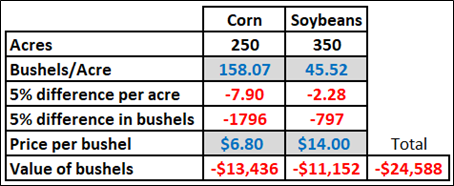Accurate production records can benefit farm profitability
How reconciling production can help manage risk and improve farm decisions.

The start of every growing season begins with a goal of maximizing production. Farm production influences a lot of decisions and outcomes for your farm, whether those outcomes are eventually to replace capital, expand your operation, or build more cash reserves. Your ability to meet those goals depends on how you approach your farm’s ability to produce. Even as planters begin to roll, having an accurate record of what was raised before will help you in-season to achieve your farm goals.
Historical success is always your guidepost. You set yield goals that are your basis for in-field decisions. Did you achieve those yield goals? More importantly, did you verify those goals after grain was sold?
There are several factors that affect what we think is stored versus what is actually sold. After years of use, producers tend to think they have a good idea of how much is in their grain bins. But without a bin measurement, those estimates can be inaccurate. Other factors can include grain moisture, test weight, or other delivery dockage fees. These factors impact whether what you sold matches what you thought you produced and if your yield goals should be reconsidered.
Impacts of Reconciled Production on Farm Profits
Reconciling production is a lot like balancing your checkbook. You want what you raised to match what you were able to sell. Having an accurate accounting of production and sales helps to identify how successful your growing year was. It also helps to identify things you did well and areas you may want to look at more closely. Those areas can include marketing decisions or whether you met production goals.

Figure 1 outlines an example farm that raises 250 acres of corn and 350 acres of soybeans. Beginning inventory is grain stored as of 12-31-2021 and will be sold in 2022. Production raised in 2022 is partially sold, but most ends up in inventory on 12-31-2022. That production will be sold in 2023. The farm reported an average of 158 bushels per acre on corn and 45 bushels per acre on soybeans.
Corn shows a discrepancy of -1,976 bushels and soybeans -797 bushels. These bushels are equal to about 5% of reported production. The negative discrepancy tells us that our farm is claiming to have used more bushels than it had to work with. This is determined by comparing sources against uses. Sources are any beginning inventories, production raised in a year, and then anything purchased for sale or feed. Uses focus on sales in a year, fed bushels, and what is left over in storage (or receivables).
How impactful is a 5% difference in yield?

Figure 2 illustrates that our example farm had a projected yield of 158.07 bushels for corn and 45.52 for soybeans. A 5% difference in yield is almost 8 bushels lower for corn and 2 bushels lower for soybeans. But what about the value of those bushels? The USDA Economic Research Service estimates market year averages for 2022/2023: $6.80 per bushel for corn and $14.00 per bushel for soybean. As Figure 2 outlines, a 5% difference in available production can mean significantly reduced sales.
The cost of production is another concern that these records help to address. If production goals were based on 5% more bushels per acre, that means more expense being put out by the farm. How much does that translate to in actual dollars?
Farms that have analyzed their financial records have an idea of that amount using their operating expense ratio. It provides an estimate of how much is invested in production activities across your whole farm. Our example farm has a ratio of 80% or $0.80 of every $1.00 that goes towards costs. In our scenario, they would have spent an estimated $19,670 (80% x $24,588) to reach those yield goals.
As your growing season moves forward, understanding your historical success can help refine your in-season decision making. Can your nutrient and pest management plans be adjusted? Are production extras to maximize yields worth their investment this year? Examples of extras may be seed treatments or fungicide applications. How does weather impact later planting decisions and field establishment goals?
While factors like weather can still impact single season yields, a consistent accounting of production can make planning more effective. For as challenges arise, verified yield goals will establish production potential. Knowing your farm’s potential can mean the difference between choices that raise more costs or help maximize your profits.
For more information on reconciling production and to use a downloadable accuracy check template, visit: https://www.canr.msu.edu/resources/production-record-accuracy-check-template.



 Print
Print Email
Email